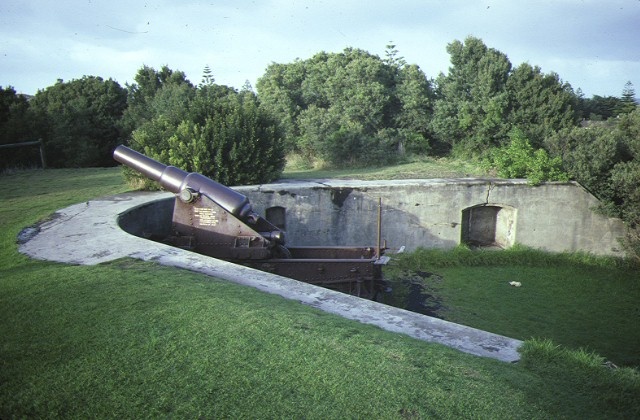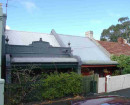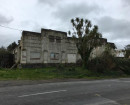GUNS AND EMPLACEMENTS
BATTERY LANE PORT FAIRY, MOYNE SHIRE
-
Add to tour
You must log in to do that.
-
Share
-
Shortlist place
You must log in to do that.
- Download report





Statement of Significance
What is significant?
The guns and emplacements at Battery Hill, Port Fairy, comprise bluestone and concrete fortifications built by the Public Works Department in 1886-87; two guns installed in 1887, associated machinery and concrete bunkers. The fort is prominently and strategically sited on a coastal dune overlooking the Southern Ocean and the mouth of the Moyne River. The site comprises a grassed area, with a flagpole at the highest point. A bluestone powder magazine (c.1860s?) is located a short distance away on the east bank of the Moyne River.
Battery Hill was an early observation site. A signalling flagstaff was established here in 1861 and also an observation hut (this was re-developed in 1887 but no longer extant). Battery Hill was established as part of a rejuvenation of Victoria's militia forces in the mid-1860s and, more particularly, with the re-establishment of the Belfast (Port Fairy) Volunteer Corps in 1866. This was one of several important Volunteer Corps set up in Victorian coastal towns (a Volunteer Rifle Corps had been formed originally at Belfast in 1859). In 1867 cannon were installed at the site and a brass band was formed. The battery was made suitable for the addition of new guns in 1874, some on traversing platforms, and further guns were acquired in 1877.
Battery Hill was further developed in the 1880s with the large-scale construction of fortifications in 1887 and the acquisition of additional guns in readiness for a much-feared Russian attack. This strategy came about in response to a heightened hysteria about foreign invasion at this time, and from the sense of vulnerability stemming from the young colony's considerable wealth and relative isolation. The guns have only ever been used only for training purposes and civic celebrations (e.g. King George V's coronation in 1911), and have never been fired in defence.
Following this upgrade of the site in 1887, some of the older guns were sold to the Borough Council. One gun was placed in the Port Fairy Botanic Gardens for ornamental purposes in 1889; it remained here for nearly 100 years before being returned to Battery Hill in 1984. Other guns were relocated to King George Square in 1911, also for ornamental purposes, but these were also returned to the Battery in 1984.
How is it significant?
The guns and emplacements at Battery Hill, Port Fairy, are of architectural, historical and scientific (technological) significance to the State of Victoria.
Why is it significant?
Battery Hill, Port Fairy, is of historical significance for its association with the early development of defence in the colony of Victoria. It is an important example of the style of fortifications built in Victoria's coastal towns as part of a broader colonial defence strategy in the 1880s. It has significance for its association with other maritime heritage sites in the town, including the Lifeboat Station (H1431), Powder Magazine, and Griffiths Island Lighthouse (H1659).
The site is of historical significance for its association with the activities of the volunteer militia, who played an important role in the social life of Victorian coastal towns. It forms an important element in the collection of public buildings in this historic township.
Battery Hill is of scientific (technological) significance as an important collection of guns used in Victoria in the nineteenth century; the collection is surpassed only by the collection at Queenscliff Fort.
[Online Data Upgrade Project 2004]
-
-
GUNS AND EMPLACEMENTS - History
Battery Hill is located on the natural high point of a coastal dune, and has a significant association with the formation of Volunteer Corps in coastal towns. After the formation of the Belfast Volunteer Corps in 1866, the Battery became a logical requirement.The Battery went through many stages of development, the most significant of which were the introduction of two 68 pound guns in 1874, the construction of a fort in 1886, and the installation of 80 pound guns in 1888.
The formation of a Volunteer Corps in Victorian coastal towns (Warrnambool, Belfast and Portland) was an important community activity for the young men of the settlements. It provided a focus for social functions, the basis for a town band and an additional hierarchy, despite the election of the NCOs. The importance of the community activity is amply reflected in the emphasis apparent by local press reports of activities. The battery at Port Fairy is on the original site and its position commands the bay and the entrance to the River Moyne. The weapons have a field of fire of 180deg. Their establishment emphasises Victoria's concern for her defence and awareness of her isolation and exposure to naval raids. The site is important for its contribution to understanding the Victorian defensive philosophy and the contribution of the volunteeer militia in providing the resources to operate the weapons. The site is enhanced by the collection of weapons that were installed over its operational life, as the thirty, 2 pound, sixty, 8 pound and 80 pound cannons are located in the area, a collection only rivalled in Victoria by that at Fort Queenscliff.
Description:
The high point of the coast dune has served as a marker for maritime moorings since the establishment of the town. A signalling flagstaff was erected in 1859 and the lifeboat bell added in 1860. The base of flagstaff had a small observation hut, rebuilt in 1887, which is no longer extant. The battery was a logical requirement following the re-establishment of the Belfast Volunteer Corps in 1866. A Volunteer Rifle Corp had been formed in 1859. The revived corps were equipped with thirty, 2 pound weight MLSB cannons in 1867, the first battery named The Mills Battery, after the Harbour Master. A brass band was also formed in 1867. The volunteers exercised with vessels of the Victorian Navy in 1873 and 1886. Regular practice for the complement of sixty to100 personnel were held and the volunteers attended camps at Sunbury, Queenscliff and Portland, as well as conducting regional manoeuvres at Belfast. They also conducted competitive artillery practice with the Warrnambool detachment. Earthworks were thrown up in 1874 to support the introduction of sixty, 8 pound cannon and the thirty, 2 pounders were mounted on traversing platforms. The 80 pound RML guns arrived in 1877. The fortifications were inspected by Sir William Jervois in October 1877 and new traversing platforms were supplied in 1880. Government expenditure on western ports resulted in plans for a more substantial battery in 1887, constructed by Messrs Lewis, Roberts and Glover and completed in October 1887. Two new 80 pound Armstrong guns on iron traversing carriages were installed and the thirty, 2 pounders were sold to the Borough for one pound in 1889 and located in the Botanic Gardens. The sixty, 8 pounders were positioned in King George's Square on the other side of the river in 1911. All the cannons were assembled in the Battery Hill area in 1984.Register of the National Estate citation. (Online data Upgrade Project October 2003)The draft statement of significance and the above history were produced as part of an Online Date Upgrade Project 2004. Sources were as follows:
Various references held in the HV file on this site.
Doyle, Aitken and Jellie. ‘Port Fairy Botanic Gardens Conservation Plan’, Prepared for Moyne Shire Council, 1999.GUNS AND EMPLACEMENTS - Plaque Citation
This exceptional collection of muzzle loading cannon were supplied by the Victorian Government to equip the local militia to oppose an envisaged Russian invasion between 1867 and 1887, when the elevated fortification and emplacements were installed.
GUNS AND EMPLACEMENTS - Permit Exemptions
General Exemptions:General exemptions apply to all places and objects included in the Victorian Heritage Register (VHR). General exemptions have been designed to allow everyday activities, maintenance and changes to your property, which don’t harm its cultural heritage significance, to proceed without the need to obtain approvals under the Heritage Act 2017.Places of worship: In some circumstances, you can alter a place of worship to accommodate religious practices without a permit, but you must notify the Executive Director of Heritage Victoria before you start the works or activities at least 20 business days before the works or activities are to commence.Subdivision/consolidation: Permit exemptions exist for some subdivisions and consolidations. If the subdivision or consolidation is in accordance with a planning permit granted under Part 4 of the Planning and Environment Act 1987 and the application for the planning permit was referred to the Executive Director of Heritage Victoria as a determining referral authority, a permit is not required.Specific exemptions may also apply to your registered place or object. If applicable, these are listed below. Specific exemptions are tailored to the conservation and management needs of an individual registered place or object and set out works and activities that are exempt from the requirements of a permit. Specific exemptions prevail if they conflict with general exemptions. Find out more about heritage permit exemptions here.Specific Exemptions:General Conditions: 1. All exempted alterations are to be planned and carried out in a manner which prevents damage to the fabric of the registered place or object. General Conditions: 2. Should it become apparent during further inspection or the carrying out of works that original or previously hidden or inaccessible details of the place or object are revealed which relate to the significance of the place or object, then the exemption covering such works shall cease and Heritage Victoria shall be notified as soon as possible. Note: All archaeological places have the potential to contain significant sub-surface artefacts and other remains. In most cases it will be necessary to obtain approval from the Executive Director, Heritage Victoria before the undertaking any works that have a significant sub-surface component.General Conditions: 3. If there is a conservation policy and planall works shall be in accordance with it. Note:A Conservation Management Plan or a Heritage Action Plan provides guidance for the management of the heritage values associated with the site. It may not be necessary to obtain a heritage permit for certain works specified in the management plan.
General Conditions: 4. Nothing in this determination prevents the Executive Director from amending or rescinding all or any of the permit exemptions. General Conditions: 5. Nothing in this determination exempts owners or their agents from the responsibility to seek relevant planning or building permits from the responsible authorities where applicable. Minor Works : Note: Any Minor Works that in the opinion of the Executive Director will not adversely affect the heritage significance of the place may be exempt from the permit requirements of the Heritage Act. A person proposing to undertake minor works must submit a proposal to the Executive Director. If the Executive Director is satisfied that the proposed works will not adversely affect the heritage values of the site, the applicant may be exempted from the requirement to obtain a heritage permit. If an applicant is uncertain whether a heritage permit is required, it is recommended that the permits co-ordinator be contacted.
-
-
-
-
-
EMOH
 Victorian Heritage Register H0252
Victorian Heritage Register H0252 -
PORT FAIRY COURT HOUSE
 Victorian Heritage Register H1480
Victorian Heritage Register H1480 -
CAPTAIN JOHN MILLS HOUSE
 Victorian Heritage Register H0253
Victorian Heritage Register H0253
-
'Lawn House' (Former)
 Hobsons Bay City
Hobsons Bay City -
1 Fairchild Street
 Yarra City
Yarra City -
10 Richardson Street
 Yarra City
Yarra City
-
-












